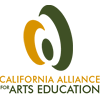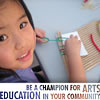Our Vision
Every student, regardless of economic circumstances, should experience a quality arts education. The visual and performing arts have a unique ability to communicate the ideas and emotions of the human spirit and connect us to our history, heritage and culture. They foster creativity, critical thinking, and collaborative skills. Beyond the classroom, the arts engender humanity and citizenship, which contribute to the vitality of communities and enrichment of the larger world.
Vision Framework
The Vision Framework represents the Alliance’s vision, its desired outcomes in the classroom, its success indicators, and the broad areas of policy and practice that the Alliance will advocate for and promote. The framework is authored by the Alliance’s Policy Council, composed of allied partners from education, business, arts and parent organizations. Read the Vision Framework [PDF: 113K].
Each year, the Policy Council identifies the most pressing issues and concerns facing arts education at the state and local levels and recommends a list of Strategic Priorities. These priorities are approved by the Board and guide the Alliance’s work for the year.
Strategic Priorities 2016 - 2017
Increase Access to Quality Arts Education
- Increase statewide network of local advocates.
- Implement models of local advocacy.
- Provide training and assistance to local advocates.
- Implement local advocacy work including the Student Voices Campaign, Arts Now California, School Board Candidate Survey, Arts Planning Initiative, LCFF advocacy, and the Local Advocacy Network.
- Activate stakeholders to influence key local and state level policy decisions (e.g. administrators, school board members, decision-makers, advocates).
- Partner with the California County Superintendents Educational Services Association (CCSESA) and regional leads, support district leaders to use arts education strategies for Title I goals.
- Explore ways to help youth access arts education outside the public school system, including incarcerated youth, after school sphere, summer learning and non-traditional educational settings.
- Determine and implement appropriate measures to evaluate success.
- Create a decision-making process to determine endorsement of ballot initiatives.
Improve the Quality of Arts Education
- Work with the Policy Council to identify trends in arts education.
- Engage the Policy Council in quality action plan to:
- Explore creating a unified message around the definition of a high-quality arts education;
- Promote sequential, standards-based arts education;
- Pursue policies to integrate arts education;
- Work with the state university system and relevant private colleges to increase both quality and quantity of arts educators.
- Pursue other specific regulatory and legislative improvements, including California’s new Accountability Framework, assessments of arts education, teacher credentials for dance and theatre, and teacher pipeline.
- Advocate for compliance with education code language that requires instruction in arts education from pre-K through grade 12.
- As a founding member of CreateCA, support the Arts Education Data Project to promote increased awareness and accountability related to arts education.











